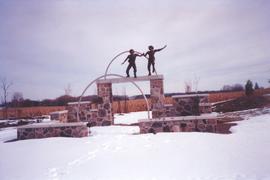Historical marker for Bethel Cemetery in Block A, Wilmot Twp.
- CA MAO Hist.Mss.1-117-6-76
- Item
- [200-?]
Part of Lorraine Roth photographs of Mennonite properties in Waterloo Region and Oxford County
Close up view of dark green plaque. Plaque reads "Bethel Cemetery This plaque is dedicated to the memory of those early pioneer families buried here who established and comprised the congregation known as Bethel Methodist and later Bethel United Church. This place of worship, established in 1861, held regular services for over 110 years. The influence from this quiet country church lives on through the lives of their descendants wherever they have located, whether in this community or in distant places. Plaque placed by Cemetery trustees - 1990".
Roth, Lorraine






